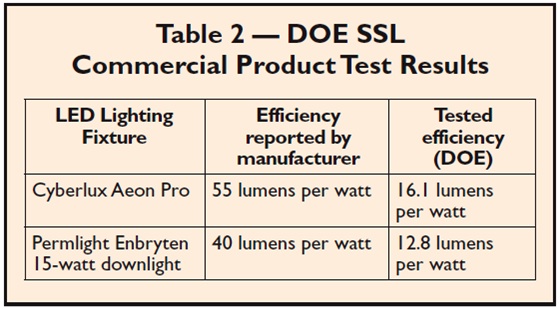
Image Credit: Martin Holladay for Energy Design Update
Evidence that some LED manufacturers exaggerate the performance of their products in marketing materials has been around for years.
The Department of Energy, through its Solid-State Lighting Commercially Available LED Product Evaluation and Reporting (CALiPERS) program, has long conducted tests on commercially available LED products. When research findings on the CALiPERS website showed that certain products did not measure up to the efficiency-per-watt levels claimed by their manufacturers, the information was sometimes picked up by news sources, including Energy Design Update, which ran an article on the subject in March 2006 and a related news item a year a later.
It wasn’t until this week, however, that a federal agency took legal action against a manufacturer over performance claims for its LED products. On Tuesday, the Federal Trade Commission filed a lawsuit in U.S. District Court in Los Angeles that alleges California-based Lights of America has been misrepresenting the output and life expectancy of its LED bulbs.
Will the FTC be a guiding light?
The LEDs cited in the FTC complaint include one that was advertised as a replacement for a 40-watt incandescent bulb, which typically produces 400 lumens. But in tests, the FTC says, the LED produces only 74 lumens. Similarly, the agency says, an LED advertised as having a 90-lumen output produced only 43 lumens in the company’s own tests.
Another issue raised in the FTC complaint is the life expectancy of some of Lights of America’s LEDs. The company rated the longevity of one of its bulbs at 30,000 hours, the suit says, although independent tests showed the bulb’s lumen intensity depreciated 80% after 1,000 hours.
After an inquiry by the New York Times, a Lights of America executive responded that the company would fight the charges and had already responded to the government’s investigation of its products by removing lumen equivalency claims from its packaging and by revising the bulbs’ lifetime ratings. The executive also told the Times that the bulbs targeted in the suit were produced before LED standards were established.
While the FTC suit won’t clear up all sources of confusion over LED performance and marketing, the need for clarity and accuracy is increasing as the lights become more widely available to consumers. The best of them really do perform well and the worst cause considerable confusion, Chris Calwell, senior research fellow and founder of energy efficiency specialist Ecos, told the Times.
“The best of the products we have tested are absolutely living up to their claims about light output and wattage equivalency; the worst of the products are clearly not,” he said, urging the FTC to provide unambiguous marketing guidance for LED manufacturers.
Weekly Newsletter
Get building science and energy efficiency advice, plus special offers, in your inbox.














3 Comments
I'm glad the LED industry is
I'm glad the LED industry is being made to clean up its act at last. I have nothing against the technology but it is not yet ready for prime time in the majority of household applications. Exaggerated claims do the industry no good.
What's the staus of LED Light Fixtures
I'm getting ready to build a house. I'd' like to make it as efficient and future-proof as possible, so I've been considering going with LED lighting if I can spring for it in the budget.
But, I read somewhere, at some point, that one of the green certification programs was awarding points for LED lighting only if a new style light socket were used for the LED lights -- to keep owners from replacing the LED lights with conventional light bulbs after the LED lighting points were awarded. That implied that a new style of light fixtures for conventional bulb applications is in the works. But, I have yet to find anything about a new style of light socket for LED lights. Nor have I seen anything about new sockets styles for florescent lights. Maybe, they were only addressing curly-q florescent light bulbs and conventional light bulb sockets/fixtures.
Was my source on this matter off base, or is something new in the works?
Larry, fixtures which only
Larry, fixtures which only take fluorescent bulbs have been around for many years, the bulbs are known as pin-based and they come in a variety of sizes and formats: the Circline fixtures which have been used as kitchen ceiling lights since the 1960's are an example. These qualify for LEED points, as do LED fixtures which come with the LED lamps built-in, e.g. under-cabinet lights.
But the question needs to be asked, is it your first priority to build an energy-efficient house or is it to gain as many certification points as possible? If the former, there's no reason to go with special fixtures unless they happen to suit your needs. Use LED or CFL lamps in standard fixtures, use special fixtures where appropriate, do the best job possible and don't worry about the points.
Log in or create an account to post a comment.
Sign up Log in